Abstract
Planetary Nebulae (PNe) that are physical members of Galactic open clusters are powerful probes that allow precise determination of their distance and crucially their initial mass on the main sequence. Here, we revisit the physical association of the PN BMP J1613–5406 with the open cluster NGC 6067 and present our preliminary results based on our new ESO/VLT FORS2 data. Our PN spectral data permit the calculation of a precise radial velocity and reddening to the PN that shows a tight consistency with the literature corresponding cluster parameters including importantly the radial velocity. Our measurements, combined with the agreement between the distances of the two objects and the fact that the PN is located well within the cluster boundaries, confirm that the PN is physically associated with the cluster. The cluster has a turn-off mass of around 5 solar masses that indicates a PN initial mass of around 5.6 solar masses. This is closer to the theoretical lower limit of core-collapse supernova formation than has ever been previously observed, providing a unique opportunity for further stellar and Galactic chemical evolution studies using this system.
1. Introduction
Planetary Nebulae (PNe) that are physically associated with Galactic star clusters have the significant advantage that some of their properties can be independently determined from studies of their host clusters. Such properties include their distances and ages that crucially allow estimation of their initial and final masses. Although the Gaia EDR3 [1] extends the sample of PNe whose accurate distances are known for those that have central stars (CSPN) brighter than the Gaia photometric limits, PNe progenitor masses can only be straightforwardly determined for PNe that are located in clusters. The numbers of such proven PNe-cluster associations are small and as such these rare cases serve as unique opportunities for in-depth PNe studies. These instances also provide key, additional data for the Initial-to-Final Mass Relation (IFMR) [2] (independent from white dwarf studies) that is vital for tracing Galactic evolution.
Today there are only six PNe confirmed to be physical members of Galactic star clusters, four in globular clusters [3,4,5] and two in open clusters [6,7,8]. We have found another PN that is likely a member of the open cluster M37 [9], Parker et al. (in preparation), but further studies are needed to confirm association due to the lack of a precise PN radial velocity, a very tight cluster membership constraint given open cluster velocity dispersions are very small (typically ∼1 km/s).
The case of the bipolar PN BMP J1613-5406 that resides in the open cluster NGC 6067 [8] is of particular scientific importance because its massive progenitor approaches the theoretical lower limit of core-collapse supernova formation and is actually the closest example to this limit currently known. Here, we provide a recap of this system, and preliminary new findings based on our fresh ESO 8 m VLT spectroscopy for the BMP J1613-5406-NGC 6067 association.
2. Observations and Methods
NGC 6067 has been extensively studied [10,11,12,13,14,15,16,17,18,19,20,21,22,23,24,25]. Taking the error weighted average of the reported cluster’s physical parameters, we estimated their mean values (see Section 3.1). Gaia DR2 data [1] were also examined for deriving the cluster’s mean distance and radial velocity.
Open clusters usually have radial velocity dispersions of less than 1 km/s. Hence, estimating a precise nebular radial velocity for any candidate cluster PN is key to demonstrating its cluster membership. We collected long slit high resolution echelle spectra from the HRS/SALT 10 m telescope that gives a radial velocity precision of less than 1 km/s, as required for our purposes. From three exposures around the PN (RA: 16:13:07 Dec: −54:04:40, RA: 16:13:03 Dec: −54:08:39, RA: 16:12:59 Dec: −54:06:08) and six target fibres (due to the nebular extent, the corresponding sky-fibres were counted as science exposures) and using the strong [NII] 6548 Å, and [NII] 6584 Å lines, we determined the PN’s accurate heliocentric mean nebular radial velocity to be compatible with cluster membership.
Additional PN optical spectral observations to cover a greater wavelength region to that from SALT were obtained for a more in-depth examination of the PN. First we examined our earlier SPIRAL/AAT 3.9m integral field spectrograph observations from 2008 (2 × 600 s exposures plus sky; IFU centered on RA: 16:13:10 Dec: −54:04:31) using the 580V and 1700I low and intermediate resolution gratings and then our long slit spectral data from our ESO/VLT XSHOOTER observations from 2014 (6 × 650 s exposures with the visual arms and 8 × 480 s exposures with the infrared arm, with the slit centered on RA: 16:13:02 Dec: −54:06:33). The reddening towards the PN was also estimated by fitting the VPHAS+ u-g stellar color of the identified nebular central star [26], which lies only a couple of arcseconds away from the best estimate of the geometric nebular centre, to published reddening lines [27] assuming a high temperature blackbody spectrum (predicted given the observed He II lines in the nebula spectrum). Considering the uncertainties imposed by its faintness, the central star’s Gaia EDR3 parallax of 1.94 ± 0.89 mas marginally agrees with the cluster’s mean, but further studies are needed to confirm that it is indeed PN’s true progenitor. Although our VLT XSHOOTER spectrum contains the suspected central star, its faintness and resultant low S/N of the stellar spectrum and relatively low wavelength resolution, do not permit a measurement of a reliable stellar radial velocity.
Finally, a PN statistical distance was estimated using the surface brightness-radius relation [28] and its mean integrated flux of = [29,30] that implies an surface brightness of erg calculated over the PN mean angular radius (estimated from its SHS imagery) of 135.5 arcseconds. This yields a statistical distance of kpc, in good agreement with the mean cluster distances from both Gaia parallaxes of cluster members and previous cluster studies.
3. Results
3.1. Demonstrating PN-Cluster Membership
Our examination of literature data shows that NGC 6067 has a supersolar metallicity of [Fe/H] = 0.19 ± 0.05, an age of 90 ± 20 Ma, a reddening of E (B − V) = 0.35 ± 0.03, a tidal radius of 12.3 arcminutes, a distance of 1.88 ± 0.10 kpc and an heliocentric corrected radial velocity of −39.79 ± 0.57 km/s. These values agree well with those found from the most extensive cluster study to date [10]. Furthermore, the examined Gaia data indicate that the cluster resides at a distance of 1.94 ± 0.07 kpc and has a mean radial velocity of −39.21 ± 0.15 kpc in very good agreement with the mean values estimated from the literature.
Our SALT HRS spectral data show that BMP J1613-5406 has a mean radial velocity of −39.93 ± 1.44 km/s, in excellent agreement to that of the cluster. Our SPIRAL and XSHOOTER spectra indicate that the PN is high excitation given the prominence of the He II line at 4686 Å (see Section 4) and has Type I chemistry [31] ([NII]/ > 0.5) and a reddening of E (B − V) = 0.38 ± 1.1 (calculated from the / Balmer decrement of our XSHOOTER spectra and the extinction law of Cardelli, Clayton and Mathis). Due to the large reddening measurement error, we consider the reddening value estimated for the central star from the VPHAS+ data of E (B − V) = 0.28 ± 0.04 to be more accurate.
The most crucial criterion for demonstrating that a PN is a cluster member is the necessary agreement of their radial velocities to within ∼1 km/s, as is the case here. Furthermore, the cluster and PN reddenings and distances also agree within the errors while the PN lies only 7 arcminutes from the cluster’s center, well within the cluster’s tidal boundaries. Our findings indicate that PN BMP J1613-5406 (see Figure 1) is a genuine member of the open cluster NGC 6067. Furthermore, the fact that NGC 6067’s sight line presents a quite steep velocity-distance gradient (−16 km/s/kpc; [13]) makes a chance coincidence of the two objects’ radial velocities highly unlikely.
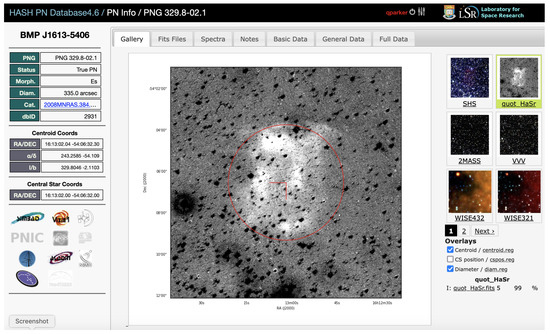
Figure 1.
A 12 × 12 arcminute continuum subtracted ( divided by short red) SuperCOSMOS Survey (SHS: http://www-wfau.roe.ac.uk/sss/halpha/ (accessed on 5 February 2022)) image of the evolved bipolar PN BMP J1613-6406 and part of its host cluster NGC 6067 from the HASH (www.haspn.space (accessed on 5 February 2022)) database main image page showing various PN data and multiwavelength imagery. North is on the top East on the left.
3.2. The PN BMP J1613-5406
Our own spectral and literature data were also used for an estimation of the nebular properties. The observed [SII] line ratios from our SPIRAL and XSHOOTER spectra indicate that the nebular electron density is close to the low-density limit (∼30 ). The PN major and minor diameters were measured from SHS imaging data [32] and using the adopted cluster distance we calculated its physical size. The HRS mean Half Width Half Maximum (HWHM) of the line and the [NII] 6584 Å line, which is split (i.e., presents two peaks due to internal nebular expansion) were both used for the calculation of the mean nebular expansion velocity and thus, its kinematic age. The nebular ionized mass was calculated following [33]. Using our XSHOOTER and SPIRAL measured emission line ratios we also calculated the excitation class parameter (for see [34] and for see [35]) and from it we estimated the central star temperature. From the same data and assuming that the nebula is optically thick (due to its bipolar shape) we estimated the crossover central star temperature and magnitude [36]. Moreover, by plotting our calculated values to evolutionary tracks [37] we estimated the mass of the central star. For the calculation of central star’s mass we used the mean stellar magnitude that was derived from the crossover method and applied to both our SPIRAL and XSHOOTER data and its error reflects their spread. The calculated parameters are summarized in Table 1.

Table 1.
Physical properties of the PN BMP J1613-5406.
The VPHAS+ data indicate that, apart from the CSPN candidate discussed above, there is no other blue star close to the nebular apparent center. Hence we assume that this is the actual nebular CSPN. By cross-correlating the VPHAS+ g band magnitudes of stars in the nebular field with APASS we found a central star V magnitude of around 20.2, close to the Gaia limit.
4. Discussion and Preliminary New Findings
We have clearly demonstrated that the PN BMP J1613-5406 is a physical member of the open cluster NGC 6067. The cluster has a turn-off mass of around 5 solar masses. Taking into account the time required for a star to leave the Main Sequence and pass through the Asymptotic Giant Branch Phase, theoretical cluster isochrones predict that the initial mass of the central star would have been ∼5.6 solar masses, close to the theoretical lower limit of core-collapse supernova formation.
Furthermore, we overplot the estimated initial and final mass of BMP J1613-5406 to a recent IFMR [2], populated by cluster white dwarfs (see Figure 2). Our point falls into the sparsely populated intermediate-to-high mass end and fits, withing the errors, with the shown trend. Since the central star’s final mass is only an approximation, better photometric data are needed for its direct detection and for directly measuring its precise mass value.
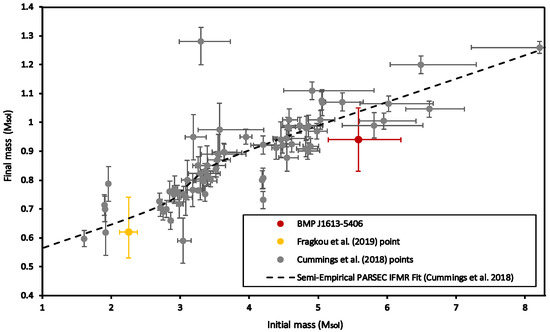
Figure 2.
The IFMR [2] with our point in red. The yellow point refers to the only other instance of a PN (PHR 1315-6555) in an open cluster [7]. [Figure credit: [8].
An in-depth analysis of the PN BMP J1613-5406 is currently in progress (Fragkou et al. In preparation). For this interim additional study we obtained in 2019 new ESO/VLT FORS2 imaging data and long-slit deep spectra (see Figure 3 and Figure 4) covering the full angular extent of the PN. These data are used for a decisive identification of the nebular central star, the measurement of the central star’s U, B, V, R, I Johnson magnitudes and nebular line fluxes for a greater range of emission lines now seen across a broader wavelength range in the blue and red optical regions. A more precise determination of the PN reddening and ionic plus elemental abundances for the identified emission lines are also made (see Table 2).
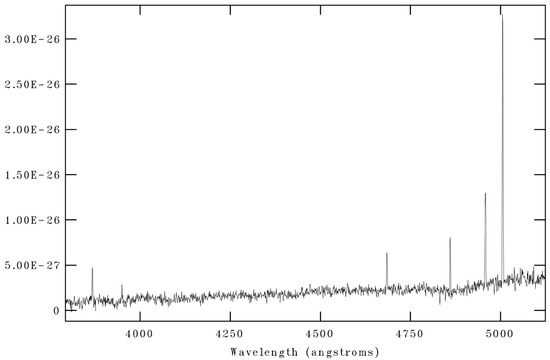
Figure 3.
Our VLT FORS2 nebular blue spectrum where the HeII 4686 Å, emission lines and [OIII] 4959, 5007 Å doublet are clearly visible.
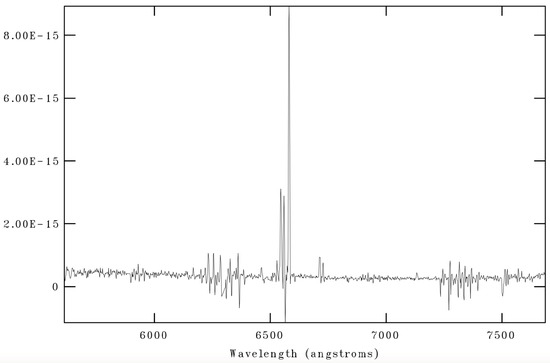
Figure 4.
Our new FORS2 2019 nebular red spectrum. There were problems with sky subtraction due to the extent of the large angular size PN across the slit that have left many residuals. The line is a little oversubtracted. Nevertheless, the strong [NII] 4648, 4684 Å emission lines indicate the nebular Type I nature also evident from the earlier SPIRAL data.

Table 2.
Preliminary results of the elemental abundances of the PN BMP J1613-5406 as estimated from our VLT/FORS2 spectral data.
For a cluster metallicity [Fe/H] equal to 0.19 [10] our estimated nebular N/O abundance ratio of around 0.89 agrees well with theoretical predictions [38] of chemical yields for a main sequence star of around 5.6 solar masses.
Our preliminary results show that there is no other blue star in the nebular field apart from the suspected central star mentioned above (see Figure 5). The central star parameters reported in Table 1 are derived from indirect methods using our XSHOOTER and SPIRAL spectral data. Our FORS2 imaging data allow a more reliable direct measurement of the central stars’s Johnson magnitudes (see Table 3).
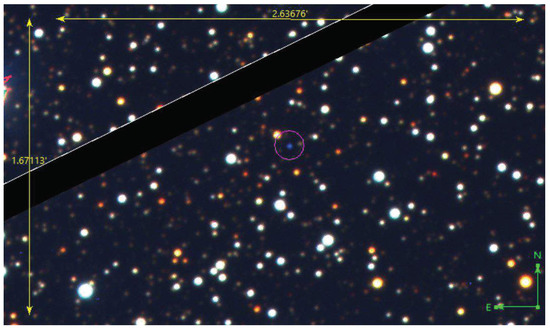
Figure 5.
A 3 color composite RGB (U:blue, B:green, V:red) FORS2 acquisition image centered on the suspected faint, blue central star, which is clearly seen as the only blue star of hundreds in the field (and circled in purple) and is located very close to he geometric centre of the PN itself. The angled black band is the slit.

Table 3.
New estimates of the (uncorrected for extinction) central star’s UBVRI Johnson magnitudes as measured from our FORS2 imaging data.
Due to issues precisely calibrating flux between the two different arms of the FORS2 data the PN reddening was measured instead from the and emission lines (which both fall in the blue arm) and using the extinction law of Cardelli, Clayton and Mathis. It was estimated to be equal to E (B − V) = 0.34 ± 0.13, very close to the cluster reddening again indicating consistency with cluster membership.
Using our FORS2 data we further plan to estimate the central star’s Zanstra temperature [39], luminosity and mass and to search for a possible low-mass companion [7] and a comprehensive photo-ionization study of the nebula with cloudy models. The estimated nebular chemical composition will facilitate the study of AGB yields of a rather high-mass star.
Author Contributions
Conceptualization, V.F. and Q.A.P.; methodology, V.F. and Q.A.P.; validation, V.F., Q.A.P., A.A.Z. and L.S.; formal analysis, V.F.; investigation, V.F. and Q.A.P.; resources, V.F., Q.A.P. and L.C.; data curation, V.F.; writing—original draft preparation, V.F.; writing—review and editing, V.F., Q.A.P., A.A.Z., L.S. and R.V.; visualization, V.F. and Q.A.P.; supervision, Q.A.P., A.A.Z. and R.V.; project administration, V.F. and Q.A.P.; funding acquisition, V.F. and Q.A.P. All authors have read and agreed to the published version of the manuscript.
Funding
This research was funded by the Hong Kong Research Grants Council, GRF grant numbers: 17326116, 17300417. This work was partially supported by UNAM-PAPIIT grant IN106720.
Data Availability Statement
The XSHOOTER data can be accessed from the ESO Science Archive Spectral Data Products, SHS data can be accessed from: http://www-wfau.roe.ac.uk/sss/halpha/ (accessed on 15 April 2017), and VPHAS+ data can be found at: http://www.vphasplus.org/ (accessed on 20 November 2018). The rest of the data can be provided by the corresponding author upon request.
Acknowledgments
Some of the observations were obtained with the Southern African Large Telescope (SALT). VF and QAP thank the University of Hong Kong for travel support. Some of the data were obtained from the ESO Science Archive Facility under request number 336270. VF thanks HKU for her PhD scholarship. VF is in grateful receipt of UNAM postdoctoral fellowship. We thank David Frew for early project work and for his input to the XSHOOTER proposal.
Conflicts of Interest
The authors declare no conflict of interest. Some of this work is published in Nature Astronomy (Fragkou et al. 2019, Nature Astronomy, Volume 3, pp. 851–857 [8]).
References
- Gaia, Collaboration; Prusti, T.; de Bruijne, J.H.; Brown, A.G.; Vallenari, A.; Babusiaux, C.; Bailer-Jones, C.A.; Bastian, U.; Biermann, M.; Evans, D.W. The Gaia mission, A&A595 (2016) A1. arXiv 2016, arXiv:1609.04153. [Google Scholar] [CrossRef]
- Cummings, J.D.; Kalirai, J.S.; Tremblay, P.E.; Ramirez-Ruiz, E.; Choi, J. The white dwarf initial–final mass relation for progenitor stars from 0.85 to 7.5 M⊙. Astrophys. J. 2018, 866, 21. [Google Scholar] [CrossRef]
- Pease, F.G. A planetary nebula in the globular cluster Messier 15. Publ. Astron. Soc. Pac. 1928, 40, 342. [Google Scholar] [CrossRef]
- Gillett, F.C.; Jacoby, G.H.; Joyce, R.R.; Cohen, J.G.; Neugebauer, G.; Soifer, B.T.; Nakajima, T.; Matthews, K. The optical/infrared counterpart(s) of IRAS 18333-2357. Astrophys. J. 1989, 338, 862–874. [Google Scholar] [CrossRef]
- Jacoby, G.H.; Morse, J.A.; Fullton, L.K.; Kwitter, K.B.; Henry, R.B.C. Planetary nebulae in the globular cluster PAL 6 and NGC 6441. Astron. J. 1997, 114, 2611. [Google Scholar] [CrossRef]
- Parker, Q.A.; Frew, D.J.; Miszalski, B.; Kovacevic, A.V.; Frinchaboy, P.M.; Dobbie, P.D.; Köppen, J. PHR 1315–6555: A bipolar planetary nebula in the compact Hyades-age open cluster ESO 96-SC04. Mon. Not. R. Astron. Soc. 2011, 413, 1835–1844. [Google Scholar] [CrossRef][Green Version]
- Fragkou, V.; Parker, Q.A.; Zijlstra, A.; Shaw, R.; Lykou, F. The central star of planetary nebula PHR 1315–6555 and its host Galactic open cluster AL 1. Mon. Not. R. Astron. Soc. 2019, 484, 3078–3092. [Google Scholar] [CrossRef]
- Fragkou, V.; Parker, Q.A.; Zijlstra, A.A.; Crause, L.; Barker, H. A high-mass planetary nebula in a Galactic open cluster. Nat. Astron. 2019, 3, 851–857. [Google Scholar] [CrossRef]
- Davis, B.D.; Bond, H.E.; Ciardullo, R.; Jacoby, G.H. Hubble Space Telescope Spectroscopy of a Planetary Nebula in an M31 Open Cluster: Hot-Bottom Burning at 3.4 M⊙. arXiv 2019, arXiv:1909.08007. [Google Scholar] [CrossRef]
- Alonso-Santiago, J.; Negueruela, I.; Marco, A.; Tabernero, H.M.; González-Fernández, C.; Castro, N. NGC 6067: A young and massive open cluster with high metallicity. Mon. Not. R. Astron. Soc. 2017, 469, 1330–1353. [Google Scholar] [CrossRef][Green Version]
- Netopil, M.; Paunzen, E.; Heiter, U.; Soubiran, C. On the metallicity of open clusters-III. Homogenised sample. Astron. Astrophys. 2016, 585, A150. [Google Scholar] [CrossRef]
- Piskunov, A.E.; Schilbach, E.; Röser, S.; Scholz, R.D. The MWSC survey is only available at the CDS via anonymous ftp to cdsarc. u-strasbg. fr (130.79. 128.5) or via http://cdsarc.u-strasbg.fr/viz-bin/qcat?J/A+A/558/A53. Astron. Astrophys. 2013, 558, A53. [Google Scholar] [CrossRef]
- Majaess, D.; Sturch, L.; Moni Bidin, C.; Soto, M.; Gieren, W.; Cohen, R.; Mauro, F.; Geisler, D.; Bonatto, C.; Borissova, J.; et al. Anchors for the cosmic distance scale: The Cepheid QZ Normae in the open cluster NGC 6067. Astrophys. Space Sci. 2013, 347, 61–70. [Google Scholar] [CrossRef][Green Version]
- Turner, D.G. The PL calibration for Milky Way Cepheids and its implications for the distance scale. Astrophys. Space Sci. 2010, 326, 219–231. [Google Scholar] [CrossRef]
- Mermilliod, J.C.; Mayor, M.; Udry, S. Red giants in open clusters-XIV. Mean radial velocities for 1309 stars and 166 open clusters. Astron. Astrophys. 2008, 485, 303–314. [Google Scholar] [CrossRef]
- Piskunov, A.E.; Schilbach, E.; Kharchenko, N.V.; Röser, S.; Scholz, R.D. Tidal radii and masses of open clusters. Astron. Astrophys. 2008, 477, 165–172. [Google Scholar] [CrossRef]
- An, D.; Terndrup, D.M.; Pinsonneault, M.H. The Distances to Open Clusters from Main-Sequence Fitting. IV. Galactic Cepheids, the LMC, and the Local Distance Scale. Astrophys. J. 2007, 671, 1640. [Google Scholar] [CrossRef]
- Mermilliod, J.C.; Mayor, M.; Burki, G. Membership of cepheids and red giants in 8 open clusters: NGC 129, 6067, 6087, 6649, 6664, IC 4725, LY 6, RU 79. Astron. Astrophys. Suppl. 1987, 70, 389. [Google Scholar]
- Coulson, I.M.; Caldwell, J.A. The Cepheid HD 144972 and the problematic distance to the open cluster NGC 6067. Mon. Not. R. Astron. Soc. 1985, 216, 671–678. [Google Scholar] [CrossRef][Green Version]
- Walker, A.; Coulson, I.M. CCD photometry of galactic clusters containing Cepheid variables. Paper 3: Photometry and identification charts for NGC 6067. SAAOC 1985, 9, 97–110. [Google Scholar]
- Walker, A.R. CCD photometry of galactic clusters containing Cepheid variables–II. NGC 6067. Mon. Not. R. Astron. Soc. 1985, 214, 45–53. [Google Scholar] [CrossRef][Green Version]
- Mermilliod, J.C. Comparative studies of young open clusters. Astron. Astrophys. 1981, 97, 235. [Google Scholar]
- Mermilliod, J.-C. Comparative studies of young open clusters. II. A atlas of composite colour-magnitude diagrams. Astron. Astrophys. Suppl. 1981, 44, 467. [Google Scholar]
- Thackeray, A.D.; Wesselink, A.J.; Harding, G.A. The cluster NGC 6067. Mon. Not. R. Astron. Soc. 1962, 124, 445. [Google Scholar] [CrossRef]
- Trumpler, R.J. 87. Preliminary Results on the Distances, Dimensions, and Space Distribution of Open Star Clusters (pp. 593–604). LicOB 1930, 420, 154. [Google Scholar] [CrossRef]
- Miszalski, B.; Parker, Q.A.; Acker, A.; Birkby, J.L.; Frew, D.J.; Kovacevic, A. MASH-II: More planetary nebulae from the AAO/UKST Hα survey. Mon. Not. R. Astron. Soc. 2008, 384, 525–534. [Google Scholar] [CrossRef][Green Version]
- Barker, H.; Zijlstra, A.; De Marco, O.; Frew, D.J.; Drew, J.E.; Corradi, R.L.; Eislöffel, J.; Parker, Q.A. The binary fraction of planetary nebula central stars-III. the promise of VPHAS+. Mon. Not. R. Astron. Soc. 2018, 475, 4504–4523. [Google Scholar] [CrossRef]
- Frew, D.J.; Parker, Q.A.; Bojicic, I.S. The Hα surface brightness—Radius relation: A robust statistical distance indicator for planetary nebulae. Mon. Not. R. Astron. Soc. 2016, 455, 1459–1488. [Google Scholar] [CrossRef]
- Frew, D.J.; Bojičić, I.S.; Parker, Q.A. A catalogue of integrated Hα fluxes for 1258 Galactic planetary nebulae. Mon. Not. R. Astron. Soc. 2013, 431, 2–26. [Google Scholar] [CrossRef]
- Frew, D.J.; Bojičić, I.S.; Parker, Q.A.; Pierce, M.J.; Gunawardhana, M.L.; Reid, W.A. Flux calibration of the AAO/UKST superCOSMOS Hα survey. Mon. Not. R. Astron. Soc. 2014, 440, 1080–1094. [Google Scholar] [CrossRef]
- Peimbert, M.; Torres-Peimbert, S. Type I planetary nebulae. IAUS 1983, 103, 233. [Google Scholar]
- Parker, Q.A.; Phillipps, S.; Pierce, M.J.; Hartley, M.; Hambly, N.C.; Read, M.A.; MacGillivray, H.T.; Tritton, S.B.; Cass, C.P.; Cannon, R.D.; et al. The AAO/UKST SuperCOSMOS Hα survey. Mon. Not. R. Astron. Soc. 2005, 362, 689–710. [Google Scholar] [CrossRef]
- Pottasch, S.R. Local space density and formation rate of planetary nebulae. Astron. Astrophys. 1996, 307, 561. [Google Scholar]
- Dopita, M.A.; Meatheringham, S.J. The evolutionary sequence of planetary nebulae. Astrophys. J. 1990, 357, 140–148. [Google Scholar] [CrossRef]
- Reid, W.A.; Parker, Q.A. An evaluation of the excitation-class parameter for the central stars of planetary nebulae. Publ. Astron. Soc. Aust. 2010, 27, 187–198. [Google Scholar] [CrossRef]
- Kaler, J.B.; Jacoby, G.H. Central star temperatures of optically thick planetary nebulae and a distance-independent test of dredge-up theory. Astrophys. J. 1989, 345, 871–880. [Google Scholar] [CrossRef]
- Weston, S.; Napiwotzki, R.; Sale, S. Central stars of Planetary Nebulae in SDSS and IPHAS. J. Phys. Conf. Ser. 2009, 172, 012033. [Google Scholar] [CrossRef]
- Karakas, A.I.; Lugaro, M. Stellar yields from metal-rich asymptotic giant branch models. Astrophys. J. 2016, 825, 26. [Google Scholar] [CrossRef]
- Zanstra, H. Untersuchungen über planetarische Nebel. Erster Teil: Der Leuchtproze & beta planetarischer Nebel und die Temperatur der Zentralsterne. Mit 4 Abbildungen. Z. Astrophys. 1931, 2, 1. [Google Scholar]
Publisher’s Note: MDPI stays neutral with regard to jurisdictional claims in published maps and institutional affiliations. |
© 2022 by the authors. Licensee MDPI, Basel, Switzerland. This article is an open access article distributed under the terms and conditions of the Creative Commons Attribution (CC BY) license (https://creativecommons.org/licenses/by/4.0/).